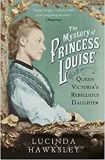The Mystery of Princess Louise: Queen Victoria's Rebellious Daughter by Lucinda Hawksley
| The Mystery of Princess Louise: Queen Victoria's Rebellious Daughter by Lucinda Hawksley | |
|
| |
| Category: Biography | |
| Reviewer: John Van der Kiste | |
| Summary: A biography of the princess who was in some ways the most remarkable and forward-looking character among Queen Victoria's children, an artist, campaigner for health reform and education. It also examines in detail the stories behind two scandals attached to her name. | |
| Buy? Yes | Borrow? Yes |
| Pages: 374 | Date: November 2014 |
| Publisher: Vintage | |
| External links: Author's website | |
| ISBN: 1845951549 | |
|
| |
As a previous biographer once called her, Princess Louise was Queen Victoria’s unconventional daughter. Always popular with the public for her comparatively easygoing manner (though, being royal, she was not averse to pulling rank), her forward-looking views on social issues, notably education and votes for women, and her artistic interests, she was certainly one of the most interesting of her family.
And there was indeed an air of mystery about her. Born in 1848, the fourth daughter and sixth child of the Queen and Prince Albert, Louise was an independent-minded woman, as the book emphasises. She was unfailingly loyal to her brothers Bertie, the Prince of Wales, so often criticised in boyhood by his ever fault-finding parents, and Leopold, the high-spirited but delicate haemophiliac. Of all the siblings she was the most rebellious, the most impatient with their mother’s controlling nature – and ever ready to remark loudly that Mama was not too unwell to open Parliament, only unwilling.
A gifted and passionate artist and sculptor, she was a friend of the Pre-Raphaelites and of radical women such as Josephine Butler and George Eliot, as well as campaigner for the rights of women, health reform and education. Fellow artists respected her talents and invited her to informal studio parties, men were not afraid to flirt with her in a way they would never have dared with her sisters, and even contemporaries who were lukewarm about royalty if not republican-minded liked her and always found her approachable. She fought with her mother, and won, for the right to attend art college. Like another, one well within living memory of most of us, she was sometimes called ‘the people’s princess’.
So what was the ‘mystery’? Louise knew she was the most attractive of the royal sisters, and as one of her nieces later remarked in old age, she was ‘keen on anything in trousers’. Rumour suggests that she had an affair with Frederick Locock, son of the Queen’s gynaecologist, and that she secretly gave birth to his son, whom he and his wife adopted when the baby was a few months old. No birth certificate for Henry Locock has ever been found, and when he died in 1907 there were theories that his death, apparently the result of an accident, might have been murder. Moreover it has long been thought that Louise, the only child of Queen Victoria never to have children of her own (or so the official records tell us), was infertile as a result of tubercular meningitis in adolescence. The author gives instances of various cover-ups by archivists over the ages, and advances a theory that when Locock delivered Louise’s secret love-child, he was ordered to ensure that the flighty young girl would never be able to conceive again. Only theory, only rumour; we will never really know.
This was not the only hint of scandal to touch the life of Princess Louise. At the age of 23 she married John Campbell, Marquis of Lorne. Coming from an impeccable Scottish family, he made a much more popular royal bridegroom than yet another German prince would have done, her three elder sisters having married Germans. It would not prove much of a marriage. Lorne, as everybody called him, was probably gay and the Prince of Wales was among those who knew about what in those days was called ‘the love that dare not speak its name’. He had tried in vain to oppose the match, ostensibly because Lorne was a Liberal Member of Parliament and the crown was meant to remain above politics, but secretly because he knew his sister would find marriage to such a man thoroughly frustrating. Lorne was appointed governor-general of Canada, but their time overseas was unhappy, particularly when Louise was seriously injured in a sleigh accident which left her with part of her ear missing, and lifelong internal injuries. Even before his period of office was over, it was noticed that Louise seemed to be spending much time apart from her husband.
That was not all. One of Louise’s closest friends was a fellow-sculptor, Edgar Boehm, best remembered for the statue of Queen Victoria beside Windsor Castle. Louise was a regular visitor to his studio, and apparently called on him one day to find him dead, felled by a sudden heart attack. The rumour persisted among artists in the Blooomsbury Group that he was in her studio at Kensington Palace, and that they were in flagrante delicto at the very moment when he had a fatal stroke or aneurism.
Not content to play the decorative wife who was content to be at her husband’s side all the time, she persistently defied Victorian convention in leading her own life much of the time. Queen Victoria was often alarmed at the state of their marriage, which more than once came close to separation, though in later years the ill-matched couple rediscovered their friendship. Increasingly eccentric as well as ready to befriend men believed to be gay, Lorne also showed some disregard for convention – so perhaps they were not so badly partnered after all. While the condition was not then recognised, he evidently suffered from dementia, or Alzheimer’s Disease, for years before his death at the age of 69. She outlived him by a quarter of a century, dying in 1939 at the age of 91.
This is a lively portrait of one of the most forward-looking personalities in the royal family. It is interesting to note that Louise remained always close to her eldest brother, later King Edward VII, and his wife Queen Alexandra – far more so then her other two surviving sisters. Yet on one vital matter they differed. Louise and Lorne were strongly pro-female emancipation, education and equal rights in general, but as the King was as firmly against ‘feminist issues’ as their mother had been, they felt unable to give public support to such movements as they would have liked.
Moreover, the author makes it clear that there have been cover-ups, suppression of facts, and tells the story of one previous researcher being escorted out of a family archive in Scotland for tactfully asking about a skeleton in the cupboard. And you thought there were enough far-fetched stories about certain aspects of Princess Diana’s life (and death)?
For the most recent comprehensive lives of the subject's mother and eldest brother, may we also recommend Victoria: A Life by A N Wilson and Bertie: A Life of Edward VII by Jane Ridley.
Please share on: ![]() Facebook,
Facebook, ![]() Twitter and
Twitter and
![]() Instagram
Instagram
![]() You can read more book reviews or buy The Mystery of Princess Louise: Queen Victoria's Rebellious Daughter by Lucinda Hawksley at Amazon.co.uk Amazon currently charges £2.99 for standard delivery for orders under £20, over which delivery is free.
You can read more book reviews or buy The Mystery of Princess Louise: Queen Victoria's Rebellious Daughter by Lucinda Hawksley at Amazon.co.uk Amazon currently charges £2.99 for standard delivery for orders under £20, over which delivery is free.
![]() You can read more book reviews or buy The Mystery of Princess Louise: Queen Victoria's Rebellious Daughter by Lucinda Hawksley at Amazon.com.
You can read more book reviews or buy The Mystery of Princess Louise: Queen Victoria's Rebellious Daughter by Lucinda Hawksley at Amazon.com.
 The Mystery of Princess Louise: Queen Victoria's Rebellious Daughter by Lucinda Hawksley is in the Top Ten Biographies 2014.
The Mystery of Princess Louise: Queen Victoria's Rebellious Daughter by Lucinda Hawksley is in the Top Ten Biographies 2014.
Comments
Like to comment on this review?
Just send us an email and we'll put the best up on the site.


